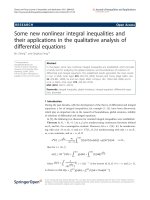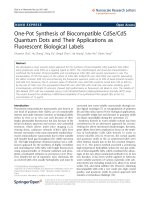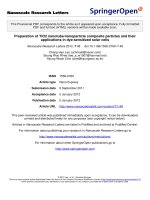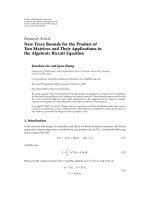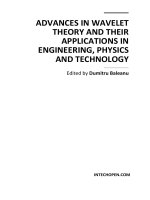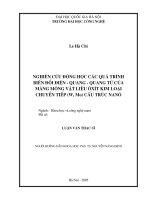Study on ingan gan quantum structures and their applications in semiconductor saturable absorber mirror 3
Bạn đang xem bản rút gọn của tài liệu. Xem và tải ngay bản đầy đủ của tài liệu tại đây (2.56 MB, 53 trang )
Chapter 3 Saturable Absorbers with GaN-based Quantum Structures
78
Chapter 3
Saturable Absorbers with
GaN-based Quantum Structures
As mentioned in Section 1.4, for high density high speed data storage
applications, high-repetition-rate ultra-short optical pulse sources in the blue/UV
wavelength region are required. To date, the blue/UV ultra-short optical pulses have
mainly been obtained by frequency conversion methods from mode-locked lasers
operating in the infrared wavelength region, such as Ti:sapphire lasers and Cr:LiSAF
lasers. The direct generation of ultra-short blue/UV pulses by passive mode-locking
has not yet been demonstrated. Although SESAMs have been successfully developed
to mode-lock solid state lasers, fiber lasers, and semiconductor lasers in a wide
wavelength region to produce ultra-short optical pulses, there is so far no SESAM
available in the blue/UV region. One of the major problems is the difficulty in
monolithically fabricating broadband high-reflective GaN-based DBRs. This problem
will therefore be discussed and the solution presented in Chapter 4.
On the other hand, to fabricate saturable absorber for the blue/UV region,
Chapter 3 Saturable Absorbers with GaN-based Quantum Structures
79
GaN-based quantum structures are considered to be suitable candidates. As discussed
in Chapter 1, owing to their large direct bandgaps, GaN-based materials have great
potentials for fabricating short-wavelength optoelectronic devices; and the research in
the GaN-based quantum structures has been greatly developed during the past decade.
Hence, in this thesis, the GaN-based quantum structures will be used to fabricate the
saturable absorbers operating in the blue region. Also, in view of the large absorption
coefficients of the GaN-based materials in the UV region, this study will only be
focused on the saturable absorbers and SESAMs operating in the blue region.
In this chapter, Section 3.1 will be focused on the nonlinear property of the
InGaN/GaN quantum well saturable absorber. In addition, aiming at the efficient
pulse shaping for future passive mode-locking applications, a novel and easy method
to reduce the absorption recovery time of the InGaN/GaN quantum well saturable
absorber will be presented in Section 3.2. With this method, InGaN/GaN MQW
samples with reduced GaN buffer thicknesses were fabricated, and the absorption
recovery time was controlled via the crystal quality of the active region. Because
these InGaN/GaN MQW samples exhibited high-density large V-pits, which could be
related with their ultra-short recovery times, Section 3.3 will be dedicated to the study
on the effects of V-pits on the morphological and optical properties of InGaN/GaN
quantum wells. Finally, in Section 3.4, the InGaN/GaN quantum dot saturable
absorber will be fabricated and its nonlinear property will be investigated. Also, a
brief comparison between the InGaN/GaN quantum well and quantum dot saturable
absorbers will be presented.
Chapter 3 Saturable Absorbers with GaN-based Quantum Structures
80
3.1 InGaN/GaN quantum well saturable absorbers
In this work, InGaN/GaN MQW samples with different numbers of quantum
wells have been studied for application as saturable absorbers. Similar characteristics
have been found for these quantum well saturable absorbers. As mentioned in Section
1.4.2, the modulation depth of a saturable absorber increases with the increased
number of quantum wells once the quantum well composition and width are fixed.
But when the number of quantum wells further increases, the crystal quality in the
active region would be degraded. Hence, in this section, we present the results from
an InGaN/GaN MQW sample consisting of eight periods of quantum wells (hereafter
referred to as InGaN/GaN 8-QW saturable absorber). It has a relatively large number
of quantum wells while still showing reasonably good crystal quality. The schematic
structure of this sample is shown in Fig. 3.1. The sample was grown on a double-side
polished c-plane (0001) sapphire substrate by MOCVD. A 30-nm LT grown GaN
buffer layer was first grown to accommodate the lattice mismatch between GaN and
sapphire. Then a 1.8-µm HT grown GaN buffer layer was grown, followed by eight
periods of 3-nm In
0.1
Ga
0.9
N (nominal composition) wells and 15-nm GaN barriers. On
the top of the last quantum well was a 30-nm GaN cap layer. For the nonlinear
transmittance study, the light is incident from the sapphire substrate side as indicated
in Fig. 3.1. So a dielectric AR coating was deposited onto the sapphire substrate by
PECVD to avoid the reflection from sapphire and air interface. The details of this AR
coating will be presented in Section 5.1.
Chapter 3 Saturable Absorbers with GaN-based Quantum Structures
81
Figure 3.1 Schematic structure of the InGaN/GaN 8-QW saturable absorber
The photoluminescence (PL) spectra from the QWs were measured at room
temperature using the Accent Rapid Photoluminescence Mapping System (RPM 2045)
with He-Cd laser (325nm) as the excitation light source. Reflectance from DBR and
SESAM were measured using the Shimadzu UV-VIS-NIR Scanning
Spectrophotometer. The nonlinear transmittance of the InGaN/GaN QW sample was
measured based on an experimental configuration of the single-beam Z-scan
technique. A substantial advantage of the Z-scan technique is that the power of the
incident laser beam is kept constant. The variation of incident energy fluence is
obtained by moving the sample along the beam axis about the focal point. The light
source used was a Kerr-lens mode-locked Ti:sapphire laser tunable between 720 and
920 nm wavelength with a repetition rate of 90 MHz. The output pulses of the
Chapter 3 Saturable Absorbers with GaN-based Quantum Structures
82
Ti:sapphire laser were then frequency-doubled using 1-mm-thick BBO crystal. A
bandpass filter was used to eliminate the fundamental infrared pulses from the
second-harmonic generated near-UV pulses. The transverse mode of the
second-harmonic beam was of near TEM
00
mode. The wavelength of the near-UV
pulses with pulse duration of about 200 fs (FWHM) was tuned between 390 and 410
nm in our measurement. A short focal length lens (f = 25 mm) was used to focus the
beams on the sample.
Figure 3.2 shows the linear transmittance spectrum from this InGaN/GaN
8-QW saturable absorber. It was recorded at room temperature using the
spectrophotometer. An enlarged plot near the GaN band edge is shown in the inset.
The absorption band edge of GaN can be clearly observed at around 365 nm, whereas
the absorption by InGaN wells is too small to be observed because of the thin
quantum well layers. Also, severe interference-induced oscillating fringes were
observed on the transmittance spectrum. This interference is mainly caused by the
thick GaN HT buffer, and it may cause similar interference fringes on the stopband of
the corresponding SESAM structure. This issue will be further investigated in Chapter
4.
Chapter 3 Saturable Absorbers with GaN-based Quantum Structures
83
Figure 3.2 Linear transmittance spectrum from the InGaN/GaN 8-QW saturable
absorber. The inset shows an enlarged part in the wavelength range of 350 - 500 nm.
Because the absorption wavelength of the quantum wells cannot be obtained
in the linear transmittance spectrum, PL was then measured at the room temperature
with the PL mapping system to obtain the emission property of the quantum wells.
From our experience, the absorption wavelength of a MQW sample is normally about
5-10 nm shorter than the PL emission wavelength. Thus, with the PL emission
wavelength, we can then estimate the absorption wavelength of the quantum well and
tune our laser source to find the suitable incident wavelength for the nonlinear
transmittance/absorption measurements. Figure 3.3 shows the room temperature PL
spectrum from the InGaN/GaN 8-QW saturable absorber. As can be observed, the PL
emission peaked at around 414 nm. Therefore, the wavelength of 408 nm was used as
the incident laser wavelength for the nonlinear transmittance/absorption
measurements.
Chapter 3 Saturable Absorbers with GaN-based Quantum Structures
84
414 nm
Figure 3.3 Room-temperature PL spectrum from the InGaN/GaN 8-QW saturable
absorber
Figure 3.4 shows the transmittance of the 408-nm light through the
InGaN/GaN 8-QW saturable absorber at different incident energy fluencies. The
transmittance curve clearly exhibited a nonlinear behavior. Also, the nonlinear
transmittance curve has been converted to saturable loss versus incident energy
fluence using Eq. (1.7), and the results are plotted in the inset of Fig. 3.4. As can be
observed, the modulation depth of this sample was about 6.5 %. Because the sample
was grown under normal crystal growth conditions and there was no further
post-growth treatment (such as ion bombardment in order to decrease the recovery
time), the sample is expected to have good crystal quality with relatively long carrier
lifetime. Thus, it should work as a slow absorber. Simulation based on the
experimental data and slow absorber theory verifies that this absorber is indeed a slow
absorber. In the inset of Fig. 3.4, the solid squares are the experimental data, and the
Chapter 3 Saturable Absorbers with GaN-based Quantum Structures
85
solid curve is the simulation curve fitted by Eq. (1.5) derived from the slow absorber
theory. Our experimental data matches well with the simulation curve for the
following values: F
sat
= 5.5 μJ/cm
2
and q
0
= 0.080.
Figure 3.4 Transmittance versus the incident energy fluence at the incident
wavelength of 408 nm for the InGaN/GaN 8-QW saturable absorber, measured at
room temperature. The inset shows the saturable loss versus incident energy fluence
(solid squares) and the simulation curve based on the slow absorber theory (solid
curve).
As shown in Fig. 3.4, clear nonlinear transmittance property has been
observed in InGaN/GaN quantum well saturable absorbers. However, it is so far
difficult to determine the appropriate modulation depth value for GaN-based saturable
absorbers. The answer could only be clear after the actual mode-locking experiment is
conducted using GaN-based saturable absorbers. The modulation depth can then be
adjusted by adjusting the number of quantum wells.
Chapter 3 Saturable Absorbers with GaN-based Quantum Structures
86
3.2 Absorption recovery time reduction in
InGaN/GaN quantum well saturable absorbers
In Section 3.1, the nonlinear transmittance properties of InGaN/GaN
quantum wells for application as saturable absorbers have been investigated. For
passive mode-locking by SESAMs, the absorption of a saturable absorber should
recover to its initial state in a short time (a few picoseconds to a few tens of
picoseconds), in order to achieve efficient pulse shaping. But the absorption recovery
times of the epitaxially grown compound semiconductors normally fall in the
nanosecond range, as will be shown later in Fig. 3.9. Therefore, many methods have
been developed to purposely reduce the recovery times of the saturable absorbers. The
most common methods are LT growth [Gupta1992], ion implantation [Delpon1998],
and proton bombardment [Gopinath2001]. More recently, recovery time reduction by
controlling the InP buffer thickness has been demonstrated in the metamorphically
grown GaAs-based SESAMs. [Suomalainen2005] The purpose of these methods is to
introduce deep levels in the bandgap of the active material so as to reduce the carrier
lifetimes through the enhanced non-radiative recombination.
In this section, we present a novel and easy method to reduce the absorption
recovery time of GaN-based saturable absorbers. The absorption recovery time is
controlled via controlling the crystal quality at the active region through engineering
the GaN buffer thickness. The influence of GaN buffers on the crystal quality and
absorption recovery time of the InGaN/GaN quantum well saturable absorber is
investigated.
Chapter 3 Saturable Absorbers with GaN-based Quantum Structures
87
Three InGaN/GaN MQW samples, marked as A, B and C, were grown by
MOCVD on double-sided polished c-plane sapphire substrates. Before the growth of
MQWs, the LT GaN buffer was first deposited at 520
o
C, followed by a HT GaN
buffer grown at 1020
o
C. The InGaN/GaN MQWs consisted of five periods of 3-nm
In
0.18
Ga
0.82
N (nominal composition) wells and 15-nm GaN barriers. Finally, a 30-nm
GaN cap was deposited. The schematic structure of these InGaN/GaN MQW samples
is shown in Fig. 3.5. The LT and HT GaN buffer thicknesses of each sample are listed
in Table 3.1. These InGaN/GaN MQW samples act as saturable absorbers.
Figure 3.5 Schematic diagram of the InGaN/GaN MQW structures
Table 3.1 LT GaN buffer and HT GaN buffer thicknesses of samples A to C
The absorption recovery times of the saturable absorbers studied in this
section were obtained by a pump-probe setup. The light sources used in this
Chapter 3 Saturable Absorbers with GaN-based Quantum Structures
88
experiment were frequency-doubled pulses from a tunable Ti:sapphire mode-locked
laser tuned at a wavelength of 410 nm, with a repetition rate of 80 MHz. The pump
beam was polarized perpendicular to the probe beam; and the probe beam energy was
approximately 4% of the pump beam energy. Both beams were collimated to a beam
diameter of ~ 50 μm. The energy fluence of the pump pulse was about 51 μJ/cm
2
. The
pump-probe signals were recorded by Si photodiodes (DET36A/M) interfaced with
the lock-in amplifier (EG&G5209) connected to the computer via GPIB interface. The
delay between the pump and probe pulses was scanned by means of a computer
controlled picomotor (New Focus 8310) attached to a delay stage. The schematic
diagram of the pump-probe setup is shown in Fig. 3.6.
Figure 3.6 Schematic diagram of the pump-probe setup
Chapter 3 Saturable Absorbers with GaN-based Quantum Structures
89
Generally, GaN-based epitaxial structures grown on sapphire substrates by
MOCVD have optimal thicknesses of 25 ~ 30 nm for the LT GaN buffer and 1.5 ~ 4
μm for the HT GaN buffer. As shown in Table 3.1, the GaN buffers in sample A were
grown with optimal thicknesses, and there was no post-growth treatment. According
to our study in Section 3.1, sample A is expected to have good crystal quality and
work as a slow absorber. The quantum well region of sample A was characterized by
X-TEM (Fig. 3.7 (a)), using both [0002] and [11 2 0] dark field imaging. As shown in
the figure, it was almost dislocation free at the quantum well region of sample A
within the 1-μm wide region shown, indicating very good crystal quality for the
growth on a lattice-mismatched substrate. The good crystal quality was also verified
by the narrow FWHM of the GaN (0002) diffraction peak and the well-defined
satellite peaks from the quantum wells, shown in the HR-XRD spectra measured in
ω-2θ geometry (See Fig. 3.8). Figure 3.9 (a) shows the time-resolved transmittance
response of sample A, recorded by the pump-probe technique. As can be observed, the
recovery time of sample A was in the nanosecond range, indicating that it is indeed a
slow absorber.
In order to achieve short recovery times, both the LT and the HT GaN buffer
thicknesses were reduced in samples B and C. Their values are tabulated in Table 3.1.
As the main function of these two GaN buffers is to accommodate the lattice
mismatch between the sapphire substrate and the GaN, it is expected that the reduced
thicknesses will lead to the introduction of more defects into the MQW regions so as
to enhance the non-radiative recombination.
Chapter 3 Saturable Absorbers with GaN-based Quantum Structures
90
To study the crystallographic lattice perfection of the InGaN/GaN MQWs
serving as saturable absorbers, grown with reduced GaN buffer thicknesses, samples
B and C were also characterized by X-TEM, using both [0002] and [11 2 0] dark field
imaging. As shown in Figs. 3.7(b)-(c), sample B exhibited a few dislocations
distributed over the quantum well region, while in sample C, a significantly larger
number of dislocations were observed, owing to its thinner LT GaN buffer. The
HR-XRD measurements were performed on these two samples to further explore their
crystal quality. The spectra recorded in ω-2θ geometry are also shown in Fig. 3.8. As
expected, sample B with a thicker LT GaN buffer compared to that of sample C
exhibited better crystal quality than sample C, as indicated by the narrower FWHM of
the GaN (0002) diffraction peak. In addition, if compared to sample A (grown under
optimal conditions), both samples B and C showed degraded crystal quality, in terms
of the rougher interfaces and the larger number of dislocations, owing to their smaller
GaN buffer thicknesses.
Chapter 3 Saturable Absorbers with GaN-based Quantum Structures
91
Figure 3.7 X-TEM micrographs from the quantum well regions of (a) sample A, (b)
sample B, and (c) sample C, using both [0002] and [11 2 0] dark field imaging.
Chapter 3 Saturable Absorbers with GaN-based Quantum Structures
92
Figure 3.8 HR-XRD spectra in ω-2θ geometry from samples A to C, taken near the
GaN (0002) diffraction peak. The Al
2
O
3
(0006) diffraction peaks are also shown as a
reference.
Subsequently, the absorption recovery times of samples B and C were
investigated by the pump-probe technique. The time-resolved transmittance responses
of samples B and C are shown in Fig. 3.9 (b)-(c). As observed, sample B showed a
single-exponential decay with an absorption recovery time constant of 90 ps. Whereas
for sample C, a double-exponential decay was observed, consisting of a fast recovery
time constant of 34 ps followed by a slow recovery time constant in hundreds of
picoseconds. This longer lasting residual component may be caused by the heat
generated by the pulses not being dissipated fast enough or by absorption due to those
longer-lived trapped carriers. [Gopinath2001] It could also be owing to the increased
number of energy barriers surrounding the increased defects. [Hangleiter2005] The
fast recovery component of sample C can be used for mode-locking, and it is much
Chapter 3 Saturable Absorbers with GaN-based Quantum Structures
93
shorter than the recovery time of sample B, owing to the increased number of
dislocations in sample C. Hence, with reduced GaN buffer thicknesses, both samples
B and C exhibit significantly shorter recovery times than those of sample A and other
InGaN/GaN MQWs grown under optimal conditions reported by other groups
[Jeon1996; Lefebvre1999; Chichibu2002; Feng2002]. The increased number of the
lattice-mismatch induced dislocations or misfits in the quantum well regions of
samples B and C have effectively enhanced the nonradiative recombinations, and
shortened the absorption recovery times. This method to achieve ultra-short recovery
time requires no post-growth treatment, and therefore is much simpler compared to
the traditional methods, such as ion implantation [Delpon1998] and proton
bombardment [Gopinath2001].
Chapter 3 Saturable Absorbers with GaN-based Quantum Structures
94
Figure 3.9 Time-resolved transmittance responses of (a) sample A, (b) sample B,
and (c) sample C, at the pump energy fluence of 51 μJ/cm
2
. The solid curves show the
exponential curve-fitting results according to the experimental data points. ΔT/T
0
is
the change in transmittance, and ΔT/T
0
= (T-T
0
)/T
0
(T, T
0
: transmittance with and
without pump beam, respectively).
It is noted that, the as-grown HT GaN buffer was only ~ 500-nm thick in
samples B and C, which is much thinner than that of sample A. Thus, it is expected
Chapter 3 Saturable Absorbers with GaN-based Quantum Structures
95
that the period of interference fringes caused by the thick GaN HT buffer should be
much larger in samples B and C, as compared to sample A. To verify this, the
reflectance spectra of samples A to C, recorded at room temperature using a
spectrophotometer, were studied, as shown in Fig. 3.10. The oscillation periods of the
fringes here should represent the extent of reflectivity fluctuations in the stopbands of
the corresponding SESAM structures. It is clear that sample A, with thick GaN
buffers, suffered from severe interference-induced oscillations. Whereas for samples
B and C, the oscillation periods of the interference fringes were largely increased.
Consequently, within the same small wavelength span (less than a half of an
oscillation period), reflectance change could be much smaller for samples B and C,
and the oscillation magnitude can further be reduced by adding an anti-reflective
coating on the incident surface.
Figure 3.10 Reflectance spectra of samples A to C
Chapter 3 Saturable Absorbers with GaN-based Quantum Structures
96
It should also be pointed out that although the LT GaN buffer in sample C
with further reduced thickness could give a shorter recovery time, this layer cannot be
made too thin. The trade-off between the absorption recovery time and the crystal
quality should be considered. We have grown a saturable absorber with an only 5-nm
LT GaN buffer. It is found that the crystal quality of the sample was severely
compromised. The quantum wells were not flat or continuous; and the surface
roughness was also largely increased. Saturable absorbers with such poor quality may
suffer from large non-saturable loss and degraded nonlinear property in terms of
largely reduced modulation depth and probably much higher saturation fluence. This
will be further discusses shortly.
As mentioned above, the absorption recovery time of the InGaN/GaN
quantum well saturable absorber has been reduced by reducing the GaN buffer
thicknesses. Subsequently, we will investigate the nonlinear properties of these
quantum well saturable absorbers. In Section 3.1, the nonlinear transmittance of an
InGaN/GaN 8-QW saturable absorber has been characterized by the Z-scan technique
at the laser repetition rate of 80 MHz. But because the Z-scan system was no longer
available by the time of the following measurements, a pump-probe system as
sketched in Fig. 3.6 was used for studying the nonlinear transmittance properties. As
described earlier, the absorption recovery time results shown in Fig. 3.9 were obtained
from saturable absorbers A to C using the pump-probe system at the laser repetition
rate of 80 MHz and with the energy fluence of 51 μJ/cm
2
. But at such a high
frequency (80 MHz), the heat generated during the measurements after each pulse
Chapter 3 Saturable Absorbers with GaN-based Quantum Structures
97
cannot be well released. Because of the heating effect, it requires a photo-detector
with a high sensitivity to clearly resolve the nonlinear transmittance curve. For our
existing detector, its sensitivity is high enough to obtain the absorption recovery curve
at the repetition rate of 80 MHz but not enough for the nonlinear transmittance
measurements at such a high frequency. Therefore, the laser repetition rate of 1 kHz
was used for the following nonlinear transmittance measurements. Under this
frequency, the incident energy fluence can be adjusted from hundreds of μJ/cm
2
up to
100 mJ/cm
2
, which were about three orders higher than the energy fluence at 80 MHz
(from less than 1μJ/cm
2
to over 100μJ/cm
2
). Actually, we have also characterized the
absorption recovery times of these saturable absorbers at the laser repetition rate of 1
kHz. It is found that absorption recovery behaviors obtained at 1 kHz and 80 MHz
show similar properties and the same trend. So it is expected that the nonlinear
transmittance curves recorded at 1 kHz could effectively represent the nonlinearity of
the quantum wells.
Figure 3.11 shows the transmittance of the 410-nm light through samples A
to C at different incident energy fluences. Also, the nonlinear transmittance curves
have been converted to saturable loss versus incident energy fluence using Eq. (1.7),
and the results are plotted in the insets of Fig. 3.11. The solid squares in the insets are
the experimental data, and the solid curve is the simulation curve fitted by Eq. (1.5)
derived from the slow absorber theory. The maximum incident energy fluence used
for these measurements was about 85 mJ/cm
2
, which was 10 – 20 % below the
photodamage threshold of GaN-based materials. It can be observed that, at the
Chapter 3 Saturable Absorbers with GaN-based Quantum Structures
98
maximum incident energy fluence, the absorption saturation has not been achieved for
all three samples. In the insets of Fig. 3.11, simulations based on the slow absorber
theory give the estimated modulation depths and saturation fluences of the three
samples, as summarized in Table 3.2. According to the simulation, the transmittance
of all three samples would be saturated at the energy fluence of more than 200 mJ/cm
2
,
which was above the damage threshold of GaN-based materials. Note that although
samples B and C had shorter recovery times (90 ps and 34 ps, respectively) than
sample A (over 1 μs), their nonlinear transmittance curves cannot be fitted with the
fast absorber theory, but are well fitted with the slow absorber theory. Therefore,
samples B and C are classified as slow absorbers. If slow absorbers B and C are used
for ultra-short pulse generation, we expect that pulses generated would be shorter than
the absorption recovery times of samples B and C. So they would be able to generate
ultra-short pulses in the duration of picoseconds or sub-picoseconds. The actual pulse
duration will also depend on the cavity length of the system. Actually, in the
application in ultra-short pulse generation, most saturable absorbers are slow saturable
absorbers, because their recovery times (nanoseconds to picoseconds) are usually
longer than the pulses generated (in the duration of picoseconds or sub-picoseconds).
Chapter 3 Saturable Absorbers with GaN-based Quantum Structures
99
Chapter 3 Saturable Absorbers with GaN-based Quantum Structures
100
Figure 3.11 Transmittance versus the incident energy fluence at the incident
wavelength of 410 nm for samples A to C. The insets show the saturable loss versus
incident energy fluence (solid squares) and the simulation curve based on the slow
absorber theory (solid curve).
As observed in Fig. 3.11, the transmittances of samples A to C at their
respective lowest incident energy fluence were 48.5%, 51% and 44.5%, respectively.
These values are low because of the large surface reflection from the GaN capping
layer. Due to the large refractive index difference between the air and the GaN
capping layer, the surface reflectance could be as high as about 30%. The lowest
transmittance for sample C is mainly attributed to its poorest crystal quality (highest
dislocation density, as indicated in Fig. 3.7), which would result in additional energy
lost through diffraction and scattering. Although sample B had poorer crystal quality
than that of sample A, the transmittance obtained at the lowest incident fluence was
slightly higher than that of sample A. This is mainly because the GaN buffer in
Chapter 3 Saturable Absorbers with GaN-based Quantum Structures
101
sample B (~ 500 nm) is much thinner than that in sample A (1.8 - 2 μm), and therefore
absorb less at the wavelength of 410 nm. It is also found that the saturation fluence
F
sat
increased with the decrease of the buffer thicknesses, as tabulated in Table 3.2.
This could also be related to the increased surface scattering loss for samples with
poorer surface morphologies. The surface roughness root mean square (rms) values of
samples A to C have been listed in Table 3.2. In addition, when the crystal quality is
degraded due to the thinner buffers, the number of defects increases. This would
increase the absorption by the defects and therefore cause the increase of the
saturation fluence. One would then expect that the modulation depth should also
increase in the materials with increased absorption. As tabulated in Table 3.2, the q
0
value decreases from samples A to C. According to Eq. (1.5), q
0
is a constant obtained
by curve fitting, and it directly represents the magnitude of the modulation depth. So
it indicates that the modulation depth actually decreases with the degraded crystal
quality from samples A to C. The modulation depth reduction with degraded crystal
quality is mainly attributed to the additional diffraction and scattering from the
defective materials, which would compromise the transmittance variation due to the
nonlinear absorption of quantum wells. As indicated in Eqn. 1.4, theoretically
speaking, the decreased modulation depth should increase the lower limit of the pulse
width that can be achieved in mode-locking. But the final pulse width actually also
depends on the recovery time of the saturable absorber. For samples B and C, the
much shorter absorption recovery times would directly result in the much shorter
pulse widths compared to that of the mode-locked pulse using sample A.
Chapter 3 Saturable Absorbers with GaN-based Quantum Structures
102
Table 3.2 Summary of nonlinear transmittance properties and surface
morphologies of samples A to C
In summary, we have demonstrated an effective reduction in the absorption
recovery time of the InGaN/GaN quantum well saturable absorber, by controlling the
crystal quality at the active region through engineering the buffer thickness. An
absorption recovery time as short as 34 ps was achieved by an InGaN/GaN quantum
well saturable absorber with a 15-nm LT GaN buffer and a 500-nm HT GaN buffer.
This method requires no post-growth treatment for recovery time reduction and is
therefore convenient. The thin GaN buffer could also largely increase the wavelength
variation/tolerance that would cause the same reflectivity change for the
corresponding SESAM structure.
3.3 V-pits related morphological and optical
properties of InGaN/GaN quantum wells
In Section 3.2, in order to reduce the absorption recovery time, InGaN/GaN
MQW samples with reduced GaN buffer thicknesses were fabricated. It was




